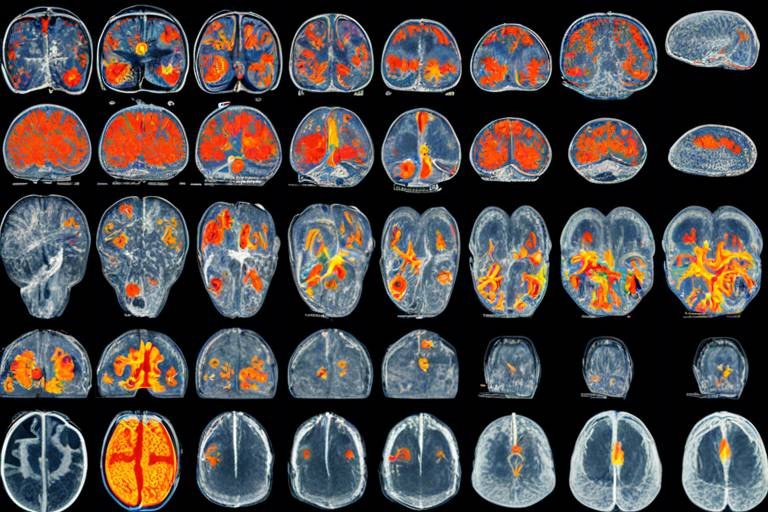The Latest Findings on Air Quality and Health Disparities
This article explores recent research on the impact of air quality on health, particularly focusing on disparities among different populations and communities. Understanding these findings can inform public policy and personal choices.
Air quality refers to the condition of the air within our environment and its impact on health. It is influenced by various factors, including pollutants released from vehicles, industrial processes, and natural sources like wildfires. The most common air pollutants include particulate matter (PM), nitrogen dioxide (NO2), sulfur dioxide (SO2), and ozone (O3). These pollutants can severely affect human health, particularly when they are present in high concentrations.
Measuring air quality involves using several indices, such as the Air Quality Index (AQI), which provides a clear picture of how polluted the air currently is or how polluted it is forecast to become. The AQI is categorized into ranges that indicate the level of health concern, from good to hazardous. For instance, an AQI of 0-50 is considered good, while an AQI over 300 is deemed hazardous.
Exposure to poor air quality has significant health implications. Numerous studies have linked air pollution to a wide range of health issues, including respiratory diseases such as asthma and chronic obstructive pulmonary disease (COPD), as well as cardiovascular problems like heart attacks and strokes. Long-term exposure to polluted air can also lead to serious conditions such as lung cancer and can negatively impact overall well-being, contributing to a shorter life expectancy.
Certain groups are more susceptible to the effects of air pollution. Vulnerable populations include children, the elderly, and those with pre-existing health conditions. Children are particularly at risk because their lungs are still developing, and they breathe more air per pound of body weight than adults. The elderly often have weakened immune systems and may suffer from chronic illnesses, making them more susceptible to the negative effects of polluted air.
Socioeconomic status plays a critical role in health disparities related to air quality. Individuals from lower-income backgrounds often live in areas with higher pollution levels, which can lead to increased exposure and worse health outcomes. Factors such as education, access to healthcare, and employment opportunities also influence how different populations experience the effects of air pollution. For instance, those with lower education levels may not have the knowledge or resources to mitigate their exposure to harmful air pollutants.
Geographical location significantly impacts air quality and health. Urban areas, often characterized by heavy traffic and industrial activity, tend to have poorer air quality compared to rural settings. Additionally, neighborhoods situated near industrial sites are more likely to experience higher levels of pollution. This geographical disparity can lead to a higher prevalence of health issues in these communities, further exacerbating existing health inequities.
Effective policies and regulations are essential for improving air quality. Governments worldwide are implementing legislation aimed at reducing air pollution and promoting public health. This includes regulations on vehicle emissions, industrial discharges, and the promotion of cleaner energy sources. However, there is still much room for improvement. For example, stricter enforcement of existing laws and the introduction of new policies can help protect vulnerable communities from the harmful effects of air pollution.
Grassroots efforts and community initiatives play a vital role in addressing air quality issues. Many communities have successfully implemented programs aimed at reducing pollution and raising awareness about the importance of clean air. These initiatives often involve local residents in decision-making processes, ensuring that their voices are heard and their needs are met.
Public awareness campaigns are crucial for educating communities about air quality. Successful campaigns have led to improved community engagement and behavioral changes regarding pollution. For instance, campaigns that promote the use of public transportation, carpooling, or biking can significantly reduce vehicle emissions and improve overall air quality.
Collaboration among various stakeholders is essential for tackling air quality issues. Partnerships between government agencies, non-profits, and local communities have proven effective in addressing health disparities linked to air pollution. By working together, these groups can pool resources, share knowledge, and implement strategies that lead to healthier environments for everyone.
- What are the main sources of air pollution? Common sources include vehicle emissions, industrial discharges, and natural events like wildfires.
- How can I improve air quality in my community? Engage in local initiatives, support clean air policies, and participate in public awareness campaigns.
- Who is most at risk from poor air quality? Vulnerable populations include children, the elderly, and individuals with pre-existing health conditions.

Understanding Air Quality
Air quality is a term that encompasses the state of the air we breathe and its chemical composition. It’s not just about how clean or polluted the air is; it’s also about understanding the various pollutants that can affect our health and the environment. Major pollutants include particulate matter (PM), nitrogen dioxide (NO2), sulfur dioxide (SO2), carbon monoxide (CO), and ozone (O3). These substances can originate from a variety of sources, including vehicle emissions, industrial activities, and even natural events like wildfires.
To grasp the concept of air quality better, we often refer to the Air Quality Index (AQI). The AQI is a standardized system that helps us understand the level of air pollution and its potential health effects. It categorizes air quality into different levels, ranging from good to hazardous. Here's a brief look at the categories:
| AQI Range | Air Quality Category | Health Implications |
|---|---|---|
| 0 - 50 | Good | Air quality is considered satisfactory, and air pollution poses little or no risk. |
| 51 - 100 | Moderate | Air quality is acceptable; however, there may be a concern for some people. |
| 101 - 150 | Unhealthy for Sensitive Groups | Members of sensitive groups may experience health effects. The general public is not likely to be affected. |
| 151 - 200 | Unhealthy | Everyone may begin to experience health effects; members of sensitive groups may experience more serious health effects. |
| 201 - 300 | Very Unhealthy | Health alert: everyone may experience more serious health effects. |
| 301 - 500 | Hazardous | Health warnings of emergency conditions. The entire population is more likely to be affected. |
Understanding how air quality is measured is crucial for making informed decisions about our health. Monitoring stations across urban and rural areas collect data on these pollutants, providing a snapshot of air quality in real time. This data is then used to calculate the AQI, which helps individuals and communities understand when it’s safe to engage in outdoor activities.
Moreover, it’s essential to recognize that air quality can fluctuate based on various factors, such as weather conditions, time of day, and even seasonal changes. For instance, air quality often deteriorates during the summer months due to increased ozone levels. Similarly, during winter, heating sources can contribute to higher levels of particulate matter. By staying informed about air quality and understanding its implications, we can take proactive steps to protect ourselves and our loved ones.
In summary, air quality is a complex and dynamic aspect of our environment that significantly impacts our health. By understanding the pollutants involved, how air quality is measured, and the factors that influence it, we can better navigate the challenges posed by poor air quality. This knowledge empowers us to make informed choices and advocate for cleaner air in our communities.
- What is the Air Quality Index (AQI)? The AQI is a standardized system used to communicate how polluted the air currently is or how polluted it is forecast to become.
- How can I check the air quality in my area? You can check local air quality by visiting government websites or using mobile apps that provide real-time data.
- What can I do to improve air quality? You can help improve air quality by reducing vehicle use, conserving energy, and supporting clean air initiatives in your community.

Health Impacts of Poor Air Quality
When we think about air quality, we often take for granted the very air we breathe. However, poor air quality can have dire consequences for our health. It’s like the silent thief that sneaks in, stealing away our well-being without us even realizing it. The reality is that air pollution is not just an environmental concern; it’s a significant public health issue that affects millions of people worldwide. Research has shown that exposure to pollutants, such as particulate matter (PM), nitrogen dioxide (NO2), and sulfur dioxide (SO2), can lead to a myriad of health problems.
One of the most alarming impacts of poor air quality is its link to respiratory diseases. Conditions like asthma, chronic obstructive pulmonary disease (COPD), and lung cancer have been closely associated with prolonged exposure to polluted air. For instance, children are particularly vulnerable; their lungs are still developing, and exposure to harmful pollutants can lead to lifelong health issues. A study found that children living in high-pollution areas are significantly more likely to develop asthma compared to those in cleaner environments.
But the effects don’t stop at the lungs. Cardiovascular problems are another serious consequence of poor air quality. Research indicates that long-term exposure to air pollution can lead to heart attacks, strokes, and other cardiovascular diseases. The American Heart Association has reported that even short-term exposure to polluted air can trigger heart-related issues, emphasizing the urgency of addressing air quality. The heart and lungs work closely together, and when one is affected, the other often suffers too.
Moreover, the long-term effects of poor air quality can extend beyond respiratory and cardiovascular health. Studies are increasingly linking air pollution to neurological problems, including cognitive decline and conditions like Alzheimer’s disease. It’s shocking to think that the very air we breathe could influence our brain health. The connections between air quality and mental health are also being explored, with some research suggesting that exposure to high levels of pollution may increase the risk of depression and anxiety.
In summary, the health impacts of poor air quality are profound and far-reaching. They affect not just individual health but also the overall well-being of communities. Understanding these impacts is essential for motivating change and inspiring action. As we continue to learn more about the effects of air pollution, it becomes clear that improving air quality is not merely an environmental goal; it’s a critical public health priority.
| Health Issues | Associated Pollutants |
|---|---|
| Respiratory Diseases | Particulate Matter (PM), Nitrogen Dioxide (NO2) |
| Cardiovascular Problems | Particulate Matter (PM), Sulfur Dioxide (SO2) |
| Neurological Disorders | Heavy Metals, Ozone (O3) |
- What are the main pollutants affecting air quality? The main pollutants include particulate matter (PM), nitrogen dioxide (NO2), sulfur dioxide (SO2), and ozone (O3).
- How does poor air quality affect children differently? Children's lungs are still developing, making them more susceptible to respiratory diseases caused by air pollution.
- Can improving air quality reduce health issues? Yes, studies have shown that reducing air pollution can lead to significant improvements in public health outcomes.

Vulnerable Populations
When we talk about air quality, it’s crucial to recognize that not everyone is equally affected by pollution. In fact, certain groups of people are particularly vulnerable to the adverse effects of poor air quality. These populations include children, the elderly, and individuals with pre-existing health conditions. But why are they at greater risk? Let's dive into the details.
Children, for instance, are still developing both physically and mentally, making them more susceptible to the harmful effects of pollutants. Their respiratory systems are not fully matured, which means exposure to air pollution can lead to long-term health issues. Imagine their lungs as delicate balloons; if they are constantly filled with toxic air, they can easily become damaged, leading to conditions like asthma and other respiratory diseases.
The elderly, on the other hand, often have weakened immune systems and pre-existing health conditions that can be exacerbated by air pollution. Think of them as seasoned trees, more likely to snap in a storm due to their age and fragility. Conditions such as heart disease and chronic obstructive pulmonary disease (COPD) can worsen with increased exposure to air pollutants, leading to serious health complications.
Moreover, individuals with pre-existing health conditions, regardless of age, face heightened risks. For example, those with asthma may find their symptoms aggravated by even small amounts of pollution, leading to more frequent hospital visits. The relationship between air quality and health is not just a matter of numbers; it’s about real lives impacted by invisible threats.
To illustrate the disparities further, let's look at a table that summarizes the increased risks faced by these vulnerable populations:
| Population Group | Health Risks | Reasons for Vulnerability |
|---|---|---|
| Children | Asthma, developmental issues | Developing lungs and immune systems |
| Elderly | Heart disease, respiratory issues | Weakened immune systems and chronic conditions |
| Individuals with Pre-existing Conditions | Worsening of existing health problems | Heightened sensitivity to pollutants |
In essence, understanding the vulnerabilities of these populations is not just an academic exercise; it’s a call to action. Communities and policymakers need to prioritize these groups when crafting public health initiatives and environmental regulations. By doing so, we can help mitigate the effects of air pollution and create a healthier environment for everyone.
- What are the main health effects of air pollution on vulnerable populations?
Vulnerable populations can experience aggravated respiratory conditions, cardiovascular issues, and developmental problems due to exposure to poor air quality. - How can communities support vulnerable populations regarding air quality?
Communities can implement awareness campaigns, improve local air quality monitoring, and advocate for better regulations to protect these groups. - Are there specific policies aimed at protecting vulnerable populations?
Yes, many environmental regulations focus on reducing emissions that disproportionately affect children, the elderly, and those with health conditions.

Socioeconomic Factors
When we talk about air quality and its impact on health, we can't ignore the elephant in the room: . These factors play a pivotal role in shaping how different communities experience air pollution and its health consequences. Imagine living in a neighborhood where the air is thick with smog, while just a few miles away, folks breathe in fresh, clean air. What makes the difference? It's often tied to income levels, education, and access to healthcare.
Individuals from lower socioeconomic backgrounds frequently face a double whammy. Not only are they more likely to live in areas with higher pollution levels, but they also have fewer resources to cope with the health impacts. For instance, families with limited financial means may not afford air purifiers or may live in homes that lack proper ventilation. This creates a vicious cycle where poor air quality exacerbates health problems, leading to increased medical expenses that further strain their finances.
Education also plays a significant role in understanding air quality issues. Those with higher education levels are often more aware of the health risks associated with pollution and are better equipped to advocate for cleaner air. In contrast, individuals with lower educational attainment may not have the same access to information or resources, leaving them vulnerable. It’s essential to recognize that knowledge is power, and in this case, it can mean the difference between life and death.
Access to healthcare is another critical factor. Communities with limited healthcare facilities often struggle to receive timely medical attention for pollution-related health issues. For example, in rural or economically disadvantaged urban areas, residents may have to travel long distances to see a doctor, which can delay diagnosis and treatment. This lack of access can lead to severe health complications that could have been prevented with earlier intervention.
To illustrate the disparities in health outcomes related to air quality, consider the following table that outlines the relationship between socioeconomic status and health impacts:
| Socioeconomic Status | Pollution Exposure | Health Outcomes |
|---|---|---|
| Low Income | High | Increased respiratory diseases, cardiovascular issues |
| Middle Income | Moderate | Some respiratory issues, manageable with healthcare |
| High Income | Low | Better overall health, fewer pollution-related issues |
In summary, socioeconomic factors are not just statistics; they represent real lives and real struggles. Addressing these disparities is crucial for ensuring that everyone, regardless of their background, has the right to breathe clean air and enjoy good health. The fight for better air quality is not just about legislation; it's about uplifting communities and ensuring that no one is left behind.
- How does socioeconomic status affect air quality exposure? Individuals from lower socioeconomic backgrounds often live in areas with higher pollution levels and have fewer resources to combat its effects.
- What role does education play in air quality awareness? Higher education levels generally correlate with increased awareness of air quality issues and better advocacy for cleaner environments.
- Why is access to healthcare important in addressing air quality issues? Limited access to healthcare can delay treatment for pollution-related health problems, leading to worse outcomes.

Geographical Disparities
When we talk about air quality, it's essential to recognize that not all locations are created equal. The air we breathe can vary dramatically based on where we live, leading to significant health disparities among different communities. Urban areas, for instance, often face a higher concentration of pollutants due to industrial activities, heavy traffic, and construction. In contrast, rural areas may experience better air quality, but they are not entirely immune to pollution—often stemming from agricultural practices or nearby industrial sites.
One of the most striking examples of geographical disparities in air quality can be seen when comparing metropolitan regions to less populated areas. Cities like Los Angeles and Beijing are notorious for their smog and particulate matter, which can lead to severe respiratory issues among their residents. In fact, studies have shown that individuals living in urban settings are more likely to suffer from conditions such as asthma and chronic bronchitis compared to those in rural environments.
However, it’s not just about urban versus rural. Industrial zones within cities can create localized air quality issues that disproportionately affect nearby communities. For example, neighborhoods located near factories or highways often experience higher levels of nitrogen dioxide (NO2) and particulate matter (PM2.5), which are linked to various health problems. This geographic concentration of pollution can lead to a cycle of disadvantage, where residents in affected areas have limited access to healthcare and fewer resources to advocate for cleaner air.
To illustrate these disparities, consider the following table that highlights average air quality index (AQI) levels in different geographical settings:
| Location Type | Average AQI | Common Pollutants |
|---|---|---|
| Urban Area (e.g., Los Angeles) | 150 (Unhealthy) | NO2, PM2.5, Ozone |
| Suburban Area (e.g., Suburbs of Chicago) | 100 (Moderate) | PM10, VOCs |
| Rural Area (e.g., Agricultural regions) | 50 (Good) | Ozone, Dust |
This table illustrates that geographical location significantly influences air quality and, consequently, health outcomes. Residents in urban areas face a higher risk of health issues due to poor air quality, while those in rural areas might enjoy cleaner air but may still encounter pollution from nearby agricultural or industrial activities.
Ultimately, understanding these geographical disparities is crucial for developing effective public health policies. By identifying the areas most affected by poor air quality, policymakers can prioritize interventions, allocate resources, and implement regulations aimed at improving air quality for vulnerable populations. Addressing these disparities not only benefits individual health but also promotes overall community well-being.
- What are the main sources of air pollution in urban areas? Urban areas typically face pollution from vehicle emissions, industrial discharges, and construction activities.
- How can I check the air quality in my area? You can check the air quality index (AQI) through local environmental agencies or websites that provide real-time air quality data.
- What steps can communities take to improve air quality? Communities can implement green spaces, promote public transportation, and advocate for stricter pollution regulations.
- Are there any health benefits to living in a rural area? Yes, rural areas often have better air quality, which can lead to lower rates of respiratory and cardiovascular diseases.

Policy and Regulation
When it comes to improving air quality, effective policies and regulations are absolutely essential. These frameworks not only aim to reduce emissions from various sources but also promote public health and environmental sustainability. Over the years, governments and organizations around the world have implemented a range of legislative measures, such as the Clean Air Act in the United States, which sets out specific standards for air quality and regulates pollutants. But how effective are these measures? And what more can be done?
One of the primary goals of air quality regulations is to protect vulnerable populations from the adverse effects of pollution. For instance, regulations often focus on limiting emissions from industrial activities, vehicle exhaust, and other major sources of pollutants. This is crucial because certain communities, especially those located near industrial zones, are often disproportionately affected by poor air quality. By enforcing stricter regulations, we can help ensure that everyone, regardless of where they live, has the right to breathe clean air.
Moreover, the implementation of air quality standards can significantly influence public health outcomes. For example, a study conducted in various urban areas revealed that cities with stringent air quality regulations reported lower rates of respiratory diseases among their residents. This highlights the direct correlation between policy enforcement and health improvements. However, it’s important to note that these regulations need to be continuously evaluated and updated based on the latest scientific research and technological advancements.
In addition to government regulations, local initiatives also play a vital role in enhancing air quality. Many communities have taken it upon themselves to adopt measures such as:
- Promoting public transportation to reduce vehicle emissions
- Encouraging the use of renewable energy sources
- Implementing green spaces to improve air filtration
These grassroots efforts can complement national policies and create a more holistic approach to tackling air pollution. However, the success of these initiatives often hinges on public awareness and community engagement. When citizens are informed about the health risks associated with poor air quality, they are more likely to advocate for change and support local policies aimed at improving their environment.
Looking ahead, there are several areas where policy improvements could make a significant impact:
| Area of Improvement | Potential Impact |
|---|---|
| Stricter emission standards for industries | Reduced pollutant levels in surrounding communities |
| Incentives for electric vehicles | Lower air pollution from transportation |
| Investment in public transport infrastructure | Decreased reliance on personal vehicles |
As we can see, the interplay between policy and air quality is complex but crucial. By continually adapting and improving regulations, we can work towards a future where clean air is a reality for all. The challenge lies not only in establishing these policies but also in ensuring that they are effectively enforced and supported by the community.
What is the Clean Air Act?
The Clean Air Act is a comprehensive federal law that regulates air emissions from stationary and mobile sources in the United States. It aims to ensure that all Americans have air that is safe to breathe.
How do air quality regulations affect public health?
Air quality regulations help reduce harmful pollutants in the air, which can lead to improved respiratory health, lower rates of cardiovascular diseases, and overall better health outcomes for communities.
What can individuals do to support air quality initiatives?
Individuals can support air quality initiatives by advocating for stricter regulations, participating in community clean-up events, using public transportation, and reducing energy consumption at home.

Community Initiatives
Community initiatives are at the forefront of the battle against air pollution, showcasing the power of collective action. These grassroots efforts often arise from local concerns, emphasizing the importance of community engagement in addressing environmental issues. When residents band together, they can create significant changes that not only improve air quality but also enhance public awareness and health outcomes. For instance, neighborhood clean-up events or tree-planting campaigns not only beautify the area but also contribute to cleaner air by absorbing harmful pollutants.
One notable example of a successful community initiative is the “Breathe Easy” program launched in various urban areas. This initiative focuses on educating residents about the sources and effects of air pollution while providing practical steps to reduce exposure. Workshops are held to inform community members about the importance of air quality and how they can monitor pollution levels using simple tools. Moreover, the program encourages participants to advocate for cleaner air policies, demonstrating that local voices can influence broader legislative changes.
Additionally, community gardens have emerged as a powerful tool in improving air quality. These gardens not only provide fresh produce but also serve as green spaces that help filter pollutants. Research shows that areas with more vegetation tend to have better air quality, as plants absorb carbon dioxide and release oxygen. Community members often come together to maintain these gardens, fostering a sense of ownership and responsibility towards their environment.
Another innovative approach is the establishment of “Clean Air Zones”. These zones are designated areas where stricter regulations on emissions are enforced, often in collaboration with local businesses and residents. By limiting the number of vehicles allowed in these zones or promoting the use of public transport, communities can significantly reduce air pollution levels. This initiative not only enhances air quality but also encourages healthier lifestyles by promoting walking and cycling.
To further illustrate the impact of these initiatives, consider the following table that outlines some successful community programs aimed at improving air quality:
| Program Name | Location | Focus Area | Impact |
|---|---|---|---|
| Breathe Easy | Various Urban Areas | Education & Advocacy | Increased awareness and policy advocacy |
| Community Gardens | Multiple Neighborhoods | Urban Greening | Improved air quality and community engagement |
| Clean Air Zones | City Centers | Emission Control | Reduced pollution levels and enhanced public health |
In addition to these structured programs, public awareness campaigns play a crucial role in fostering community initiatives. These campaigns often utilize social media, local events, and educational materials to spread the word about air quality issues. The more informed a community is, the more empowered they become to take action. People often underestimate the power of knowledge; when armed with the right information, communities can effectively advocate for their right to clean air.
Ultimately, community initiatives are a testament to the idea that change begins at the local level. By harnessing the collective power of individuals, these programs can lead to substantial improvements in air quality and health outcomes. As we look towards the future, it’s clear that community involvement will be essential in tackling the pressing issue of air pollution. The road may be long, but with determination and collaboration, cleaner air is within reach.
- What are community initiatives? Community initiatives are local efforts aimed at addressing specific issues, such as air quality, through collective action and engagement.
- How can I get involved in community initiatives? You can participate by joining local organizations, attending community meetings, or starting your own initiative focused on air quality.
- Why are community initiatives important for air quality? They raise awareness, promote action, and can lead to significant changes in local policies and practices that improve air quality.

Public Awareness Campaigns
Public awareness campaigns are essential in the fight against air pollution, acting as the bridge between scientific research and community action. Think of these campaigns as the megaphones that amplify the voices of scientists, health professionals, and concerned citizens. They aim to educate the public about the dangers of poor air quality and the steps individuals can take to mitigate its effects. When communities become informed, they can make better decisions, advocate for cleaner environments, and ultimately improve their health outcomes.
One of the most effective strategies used in these campaigns is the dissemination of information through various media channels. Social media, local news outlets, and community bulletins serve as platforms for sharing vital information about air quality levels, health risks, and protective measures. For instance, campaigns often highlight the importance of staying indoors on days when air quality is poor, especially for vulnerable groups such as children and the elderly. Moreover, they encourage individuals to participate in activities like tree planting or using public transportation, which can significantly contribute to reducing air pollution.
Successful public awareness campaigns often incorporate engaging visuals and storytelling to capture the audience’s attention. For example, infographics can illustrate how air pollution affects health, while videos can showcase real-life stories of individuals impacted by poor air quality. These narratives not only inform but also evoke emotions, making the message more relatable and urgent. Here’s a brief overview of some successful campaigns:
| Campaign Name | Focus Area | Impact |
|---|---|---|
| Clean Air Day | Community Engagement | Increased participation in local clean-up events and tree planting. |
| Smog-Free Cities | Urban Pollution | Raised awareness about the effects of urban smog on health and promoted public transport. |
| Air Quality Awareness Week | Health Education | Provided resources and workshops on how to monitor air quality and protect oneself. |
Moreover, the effectiveness of these campaigns is often measured through community engagement metrics. Surveys and feedback forms can help organizers understand the impact of their efforts and identify areas for improvement. Engaging the community in discussions about air quality can lead to more tailored and effective strategies, ensuring that the campaigns resonate with the specific needs of the population they aim to serve.
In conclusion, public awareness campaigns are not just about spreading information; they are about fostering a culture of responsibility and action towards air quality issues. By empowering individuals with knowledge and resources, these initiatives can lead to significant behavioral changes, ultimately resulting in healthier communities. As we continue to confront the challenges posed by air pollution, let’s remember that informed citizens are the best advocates for cleaner air and a healthier future.
- What are public awareness campaigns? These are organized efforts to inform and educate the public about specific issues, such as air quality and its health impacts.
- How can I get involved in local air quality campaigns? You can participate by attending community meetings, volunteering for local clean-up efforts, or sharing information on social media.
- Why are these campaigns important? They raise awareness about air pollution, encourage community action, and can influence policies that protect public health.
- What role does social media play in these campaigns? Social media allows for rapid dissemination of information, engagement with the community, and mobilization of resources for collective action.

Collaborative Efforts
When it comes to tackling the complex issue of air quality, no single entity can do it alone. The **collaborative efforts** between various stakeholders—government agencies, non-profits, local communities, and even businesses—are essential for making a meaningful impact. Think of it like a well-orchestrated symphony; each player has a unique role that contributes to a harmonious outcome. By pooling resources, knowledge, and expertise, these collaborations can address health disparities linked to air pollution more effectively than isolated efforts.
For instance, government agencies often provide the regulatory framework and funding necessary for air quality initiatives, while non-profits can mobilize community members and raise awareness about the health risks associated with pollution. Local businesses can also play a part by adopting sustainable practices that minimize emissions. This multi-faceted approach not only enhances the effectiveness of air quality programs but also fosters a sense of community ownership and responsibility.
One shining example of successful collaboration is the partnership between the Environmental Protection Agency (EPA) and local health organizations. Together, they have launched various initiatives aimed at reducing air pollution in urban areas. These initiatives often include:
- Community Monitoring Programs: Empowering residents to monitor air quality in their neighborhoods and report findings to authorities.
- Educational Workshops: Providing training on the health impacts of air pollution and how to mitigate exposure.
- Policy Advocacy: Collaborating to push for stricter regulations on emissions from industries and vehicles.
Moreover, community-driven efforts, such as neighborhood clean-up days and tree-planting initiatives, also play a significant role in combating air pollution. These activities not only improve local air quality but also enhance community spirit and engagement. When people see tangible results from their efforts, it creates a ripple effect, inspiring more individuals to take action.
In addition to grassroots initiatives, partnerships with academic institutions can provide valuable research that informs policy decisions. Universities often conduct studies that reveal the specific health impacts of air pollution on different populations, which can lead to targeted interventions. For instance, a recent study conducted by a local university highlighted the disproportionate effects of air pollution on low-income neighborhoods, prompting local government to allocate resources for air quality improvement in those areas.
In conclusion, the fight against air pollution requires a **collaborative approach** that engages all sectors of society. By working together, we can create healthier environments and reduce the disparities that many communities face regarding air quality. The more diverse the collaboration, the more comprehensive and effective the solutions will be. It’s not just about cleaner air; it’s about building resilient communities that thrive together.
1. What are the main pollutants affecting air quality?
The primary pollutants include particulate matter (PM), nitrogen dioxide (NO2), sulfur dioxide (SO2), carbon monoxide (CO), and ozone (O3). Each of these can have significant health impacts, especially when present in high concentrations.
2. How can I improve air quality in my community?
You can participate in local clean-up events, advocate for greener policies, and support initiatives that promote public transportation and reduce vehicle emissions.
3. What should I do if I live in an area with poor air quality?
Consider using air purifiers indoors, staying indoors during high pollution days, and advocating for local policies that aim to reduce pollution sources.
4. Are there any resources available for learning more about air quality?
Yes, websites like the Environmental Protection Agency (EPA) and local health departments often provide valuable information and resources related to air quality monitoring and health impacts.
Frequently Asked Questions
- What is air quality and why is it important?
Air quality refers to the condition of the air within our environment and its potential impact on health. It's crucial because poor air quality can lead to serious health issues, affecting not just individual well-being but also public health at large.
- What are the main pollutants that affect air quality?
The primary pollutants include particulate matter (PM), nitrogen dioxide (NO2), sulfur dioxide (SO2), carbon monoxide (CO), and ozone (O3). Each of these pollutants comes from various sources, such as vehicle emissions, industrial activities, and even natural events like wildfires.
- How does poor air quality affect health?
Poor air quality can lead to a range of health issues, including respiratory diseases, cardiovascular problems, and even long-term effects like reduced lung function and increased risk of cancer. The impact varies based on exposure levels and individual health conditions.
- Who are the most vulnerable populations affected by air pollution?
Certain groups, including children, the elderly, and individuals with pre-existing health conditions, are more susceptible to the effects of air pollution. Their bodies may be less capable of coping with harmful pollutants, putting them at greater risk for health complications.
- How do socioeconomic factors influence health disparities related to air quality?
Socioeconomic status significantly impacts health outcomes related to air quality. Factors such as income, education, and access to healthcare can determine how much exposure individuals have to pollutants and their ability to seek treatment for health issues caused by poor air quality.
- Are there geographical differences in air quality and health risks?
Yes, geographical location plays a crucial role in air quality. Urban areas typically have higher pollution levels due to traffic and industrial activities, while rural areas might have cleaner air. However, even rural communities can face risks from nearby industrial sites or agricultural practices.
- What policies are in place to improve air quality?
Various regulations exist to combat air pollution, including the Clean Air Act in the United States, which sets limits on emissions from industries and vehicles. However, continuous evaluation and improvement of these policies are necessary to address ongoing challenges effectively.
- How can communities address air quality issues?
Communities can implement grassroots initiatives to raise awareness about air quality and promote cleaner practices. Successful programs often involve collaboration among local governments, non-profits, and residents, aiming to reduce pollution and improve public health.
- What role do public awareness campaigns play?
Public awareness campaigns are essential for educating communities about the importance of air quality. They can lead to increased engagement and behavioral changes, encouraging individuals to adopt practices that contribute to cleaner air.
- How can collaboration improve air quality efforts?
Collaborative efforts among government agencies, non-profits, and local communities can create a comprehensive approach to tackling air quality issues. By pooling resources and expertise, these partnerships can effectively address health disparities linked to pollution.



















